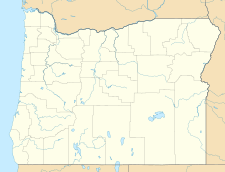Newton Clark Glacier facts for kids
Quick facts for kids Newton Clark Glacier |
|
|---|---|
| Type | Mountain glacier |
| Location | Hood River County, Oregon, United States |
| Coordinates | 45°22′00″N 121°41′12″W / 45.36667°N 121.68667°W |
| Area | 345 acres (140 ha) (2004 estimate) |
| Terminus | Talus |
| Status | Retreating |
The Newton Clark Glacier is a large ice mass found on the side of Mount Hood in Oregon, United States. It's a type of alpine glacier, which means it forms high up in the mountains. This glacier is located on the southeast part of Mount Hood.
The Newton Clark Glacier stretches from about 10,400 feet (3,170 meters) down to 6,500 feet (1,980 meters) above sea level. It is completely inside the Mount Hood Wilderness, a protected natural area.
What is the Newton Clark Glacier?
The Newton Clark Glacier is one of the many glaciers that cling to the slopes of Mount Hood. Glaciers are like very slow-moving rivers of ice. They form when snow falls and builds up over many years, compacting into thick ice.
This particular glacier is an important part of the Mount Hood landscape. It helps shape the mountain and provides water to streams as it melts.
Where is it Located?
You can find the Newton Clark Glacier on the southeastern side of Mount Hood. Mount Hood itself is a tall, inactive volcano in Oregon. The glacier is part of the Mount Hood National Forest, a huge area of forests and mountains.
Being in the Mount Hood Wilderness means the area around the glacier is kept wild and natural. This helps protect the glacier and the plants and animals that live nearby.
How is the Glacier Changing?
Like many glaciers around the world, the Newton Clark Glacier is getting smaller. Scientists have been watching it closely for many years. They've seen some big changes.
Between 1907 and 2004, the glacier lost almost a third of its total size. That's a lot of ice! During the same time, the very end of the glacier, called the glacier terminus, moved back about 310 meters (1,017 feet). This means the glacier is shrinking and retreating up the mountain.
Scientists continue to study glaciers like Newton Clark to understand how they are changing. These changes can affect water supplies and ecosystems in the future.


